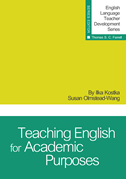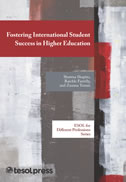Free TESOL Quarterly Article:
"Towards a Plurilingual Approach in English Language Teaching: Softening the Boundaries Between Languages"
September 2013: Volume 47, Issue 3
This article first appeared in TESOL Quarterly, Volume 47, Number 3, pgs. 591–599. Subscribers can access issues here. Only TESOL members may subscribe. To become a member of TESOL, please click here, and to purchase articles, please visit Wiley-Blackwell. © TESOL International Association.
This forum article presents a critique of the policy of language isolation in TESOL and proposes an innovative plurilingual approach to the teaching of English that softens the boundaries between languages. First, the article looks at how teaching English as a second or foreign language has traditionally been associated with teaching practices that encourage the isolation of English from the other languages in the student’s repertoire and in the school curriculum. Then, some proposals that consider the need to make the boundaries between languages softer are considered, including the concept of plurilingualism of the Council of Europe. The article ends by providing some teaching implications for TESOL professionals.
English is the dominant language of international communication, and as such it is intensively used and taught in the European Union (EU) as well as elsewhere in the world. The results of the European Survey on Language Competences (ESLC) indicate that, outside the United Kingdom, English is the most widely taught foreign language in the EU with the exception of the Flemish and German communities of Belgium (European Commission, 2012). This survey reports on language skills, including reading, writing, and listening in foreign languages. The survey focused on 53,000 secondary students from 14 European countries who completed tests of second language proficiency. The countries with the highest percentages of students who reach the upper-intermediate level, that is, the B2 level of the Common European Framework of Reference for languages (CEFR), in secondary school were Malta (60%), Sweden (57%), and Estonia (41%). The countries with the lowest scores were France (5%), Poland (10%), and the French community in Belgium (10%). The CEFR will be discussed in more detail below.
Learning English in Europe cannot be separated from the use of other languages in education. English is most often a language directly addressed in the curriculum and accompanies other state languages or minority languages that are also given priority within the curriculum (De Houwer & Wilton, 2011; Gorter, 2013). This article discusses hard and soft boundaries between the teaching of English and other languages in the European context. In the next section, we look at how teaching English as a second or foreign language has traditionally been associated with teaching practices that encourage the isolation of English from other languages in the student’s repertoire and in the school curriculum. Then, we look at how this policy has been questioned and how the boundaries between languages need to be made softer and more fluid.
This article first appeared in TESOL Quarterly, 47, 591–599. For permission to use text from this article, please go to Wiley-Blackwell and click on "Request Permissions" under "Article Tools."
doi: 10.1002/tesq.121
TC Monthly Giveaway Congratulations to ErinKate Sousa, of Maine, USA, for being the winner of the September 2014 TESOL Connections Monthly Giveaway. ErinKate won a free subscription to TESOL Quarterly.
This month, TESOL is giving away
A free registration to the
TESOL Annual Convention
& English Language Expo
in Toronto Canada
25 March–28 March 2015!

Join 7,000 of your colleagues for a year of professional development—in just 4 days!
The TESOL annual convention will bring professionals and scholars from around the world to Toronto. With more than 900 sessions, you’ll be able to explore not only teaching techniques that work, but the latest research in the field, the newest software and publications on the market, and just about anything else that supports English language educators.
View all convention details on the TESOL Convention Website.
Click here to enter
Drawing closes 28 October 2014, 11:59 pm EST
TESOL Blogs Interested in writing a blog for TESOL?
Contact Tomiko Breland with your idea or for submission details.
Check out the latest TESOL Blogs:
|
The Power of Collaboration and Active Engagement for ELs, by Judie Haynes
 Teachers in many general education classes lecture to impart information to their students. This teaching method prevents English learners (ELs) from benefiting and participating in the content instruction. ELs learn best when they collaborate with classmates to create a product of some kind (Cohen, 1998). Many ELs come from cultures where collaboration is the norm. Collaboration provides rich opportunities for language learning and oral language practice (Kagan 1995). Read More. Teachers in many general education classes lecture to impart information to their students. This teaching method prevents English learners (ELs) from benefiting and participating in the content instruction. ELs learn best when they collaborate with classmates to create a product of some kind (Cohen, 1998). Many ELs come from cultures where collaboration is the norm. Collaboration provides rich opportunities for language learning and oral language practice (Kagan 1995). Read More.
|
|
A New Way of Looking at Teacher Evaluation, by TESOL President Yilin Sun
 In this blog, I’d like to share a new way of conducting teacher evaluation. In his book, Becoming a Critically Reflective Teacher, Stephen Brookfield (2007) argued that conversations with faculty peers are essential to the development of teachers. However, he emphasized the need for creating a clearly defined reflective culture, so that faculty can shift away from faultfinding and defensiveness toward the possibility of transformation. In this blog, I’d like to share a new way of conducting teacher evaluation. In his book, Becoming a Critically Reflective Teacher, Stephen Brookfield (2007) argued that conversations with faculty peers are essential to the development of teachers. However, he emphasized the need for creating a clearly defined reflective culture, so that faculty can shift away from faultfinding and defensiveness toward the possibility of transformation.
How to turn this “utopian” vision of colleagues’ discussion about teaching and learning into reality is a difficult task, but not an impossible one. Read More. |
|
ESP and Communicating Bad News, by Kevin Knight
 A couple of years ago, I heard the following ESP story related to the global financial crisis. An ESPer had been conducting language training in a company when his students asked him to teach them how to communicate bad news. The students explained to the teacher that the shares of stock that they had sold to their client for a pension fund had dropped in value from 100 dollars per share to 7…not to 7 dollars per share but to 7 cents per share! In this TESOL Blog post, I will address the issue of communicating such bad news. Read More. A couple of years ago, I heard the following ESP story related to the global financial crisis. An ESPer had been conducting language training in a company when his students asked him to teach them how to communicate bad news. The students explained to the teacher that the shares of stock that they had sold to their client for a pension fund had dropped in value from 100 dollars per share to 7…not to 7 dollars per share but to 7 cents per share! In this TESOL Blog post, I will address the issue of communicating such bad news. Read More.
|
|
Excellent Academic Journals to Stay Up-to-Date in EL Writing, by Elena Shvidko
 In one of my previous blog posts, I introduced five journals concerned with different issues in second language writing. There are obviously other academic journals in the field that publish articles related both to research in second language writing and writing pedagogy. So let me add a few more to the list introduced earlier. Read More. In one of my previous blog posts, I introduced five journals concerned with different issues in second language writing. There are obviously other academic journals in the field that publish articles related both to research in second language writing and writing pedagogy. So let me add a few more to the list introduced earlier. Read More.
|
TESOL Bookstore

NEW from TESOL Press!
 Cat Got Your Tongue? Teaching Idioms to English Learners Cat Got Your Tongue? Teaching Idioms to English Learners
Paul Mcpherron & Patrick T. Randolph
Why do questions about idioms often leave us "tongue-tied" in our classrooms? This book takes a look at recent research and classroom practice for teaching idioms to English learners around the world.
Teaching English for Academic Purposes
Ilka Kostka and Susan Olmstead-Wang
Part of the English Language Teacher Development Series, this easy-to-follow guide shows how learning academic language can be achieved by developing a set of skills that can be honed with practice, effective instruction, and motivation.
 Fostering International Student Success in Higher Education Fostering International Student Success in Higher Education
S. Shapiro, R. Farrelly, Z. Tomaþ
Gain a better understanding of international students' needs through quotes, anecdotes, and reflection questions, and learn specific strategies, resources, and activities that serve as tools for responding to common instructional challenges.
|
 |
|
|
 |
| ESL Teacher (Middle School), Center City Public Charter Schools, Washington, DC, USA
Director of English Learner Programs, San Rafael City Schools, San Rafael, California, USA
Coordinator of Multilingual Learning, Denison University, Granville, Ohio, USA
Want to post your open positions to Job Link? Click here.
To browse all of TESOL's job postings, check out the TESOL Career Center. |
 |
|
 |
| ADVERTISEMENT |
 |
 |
|